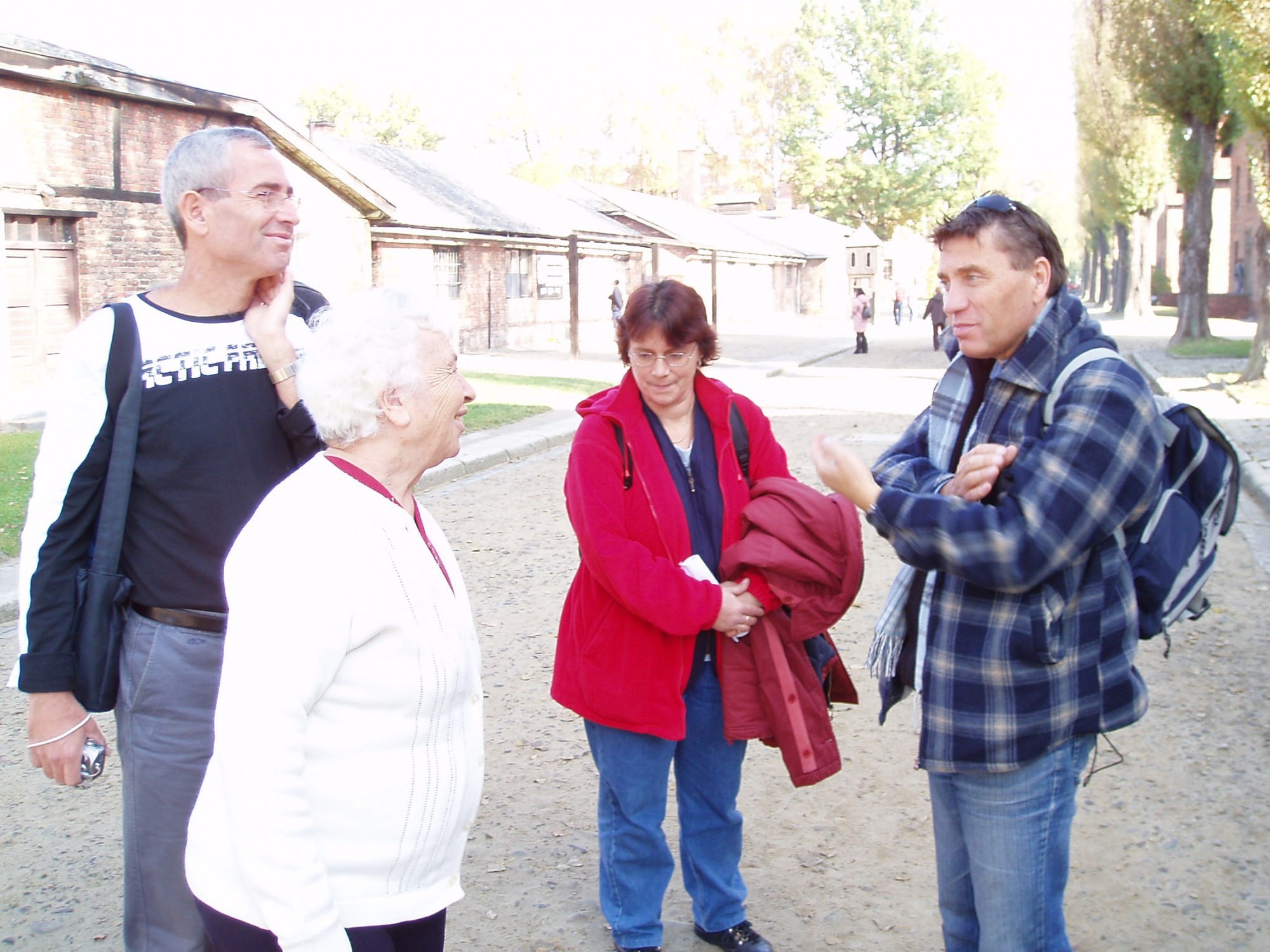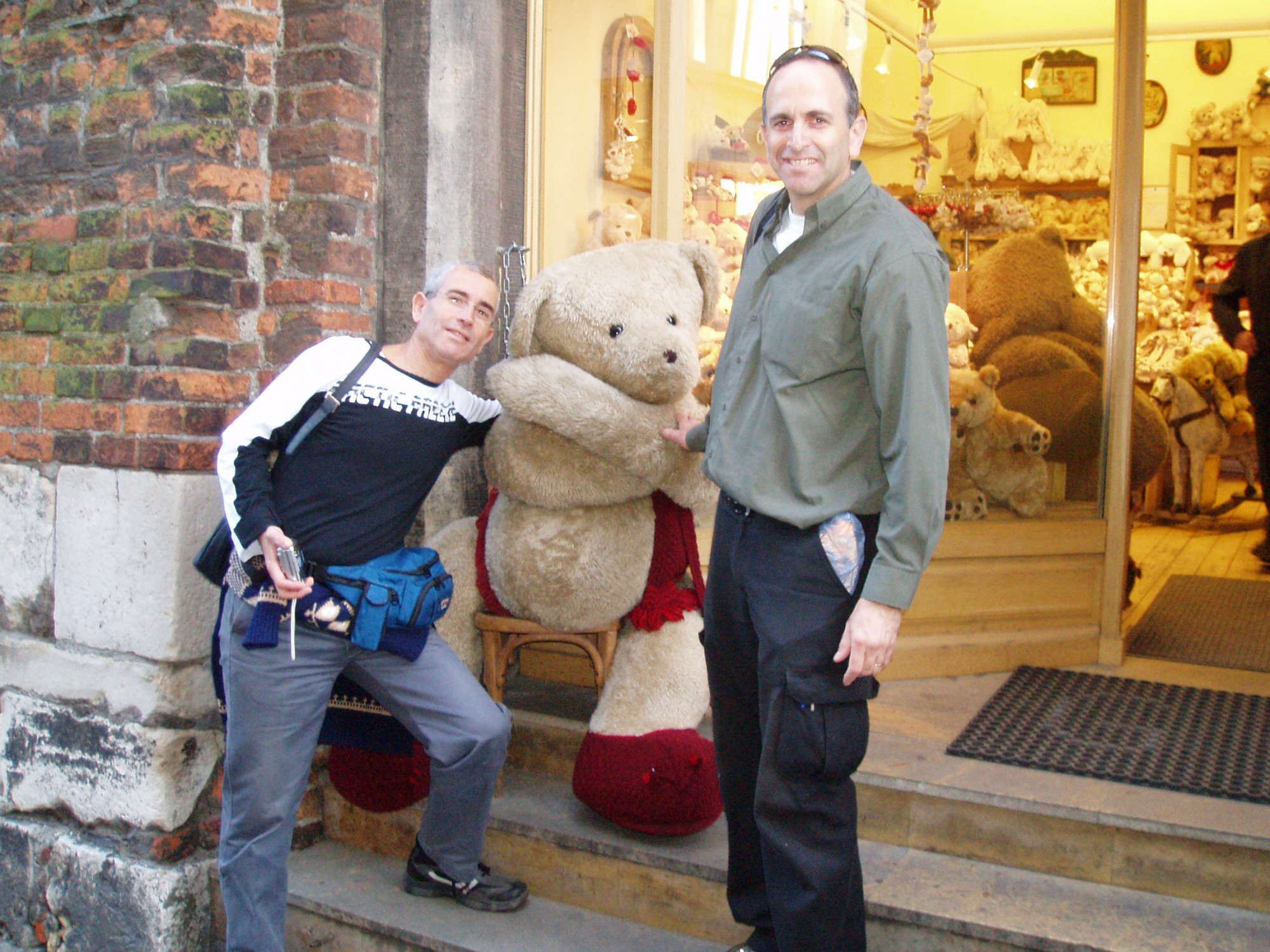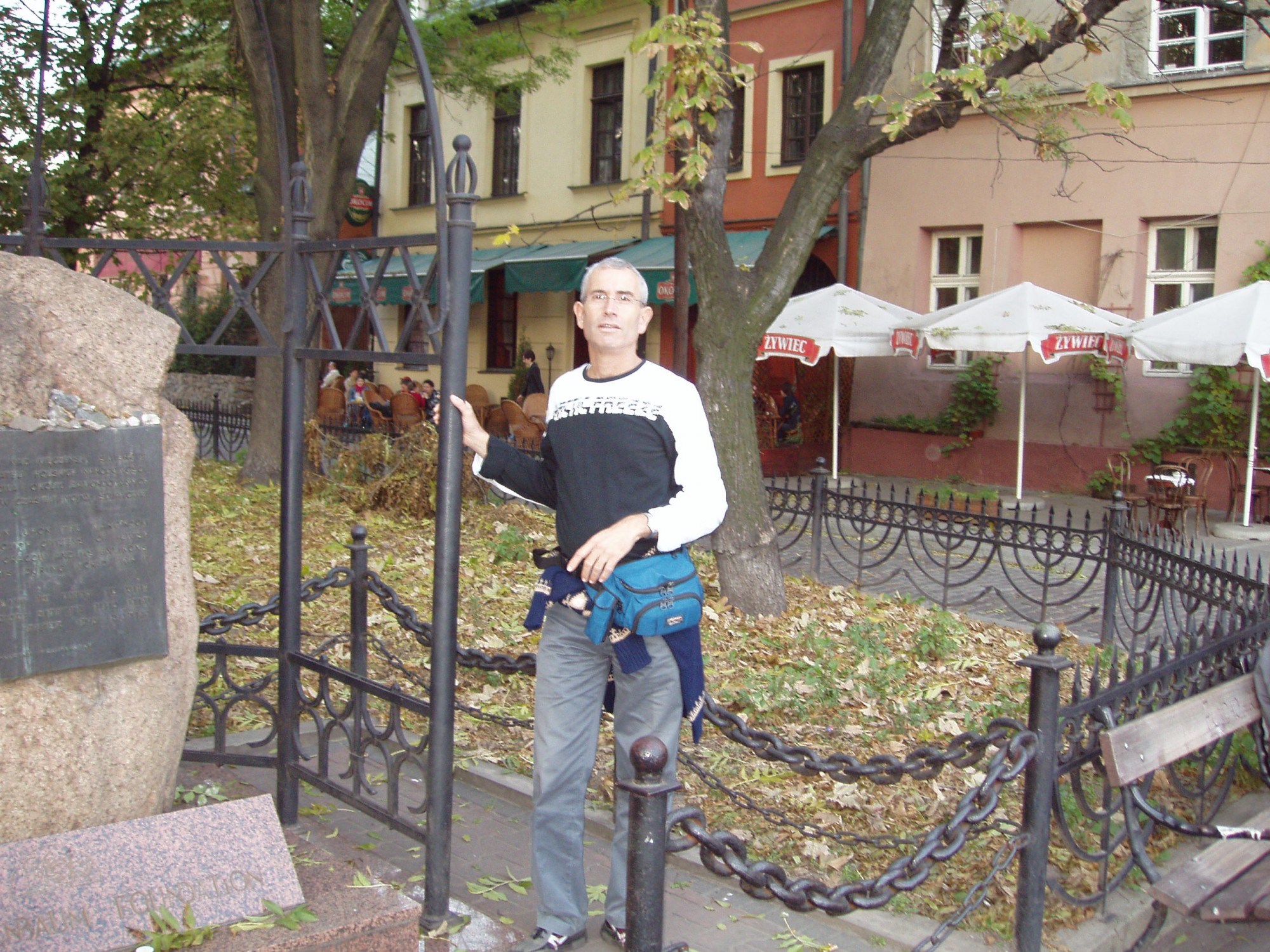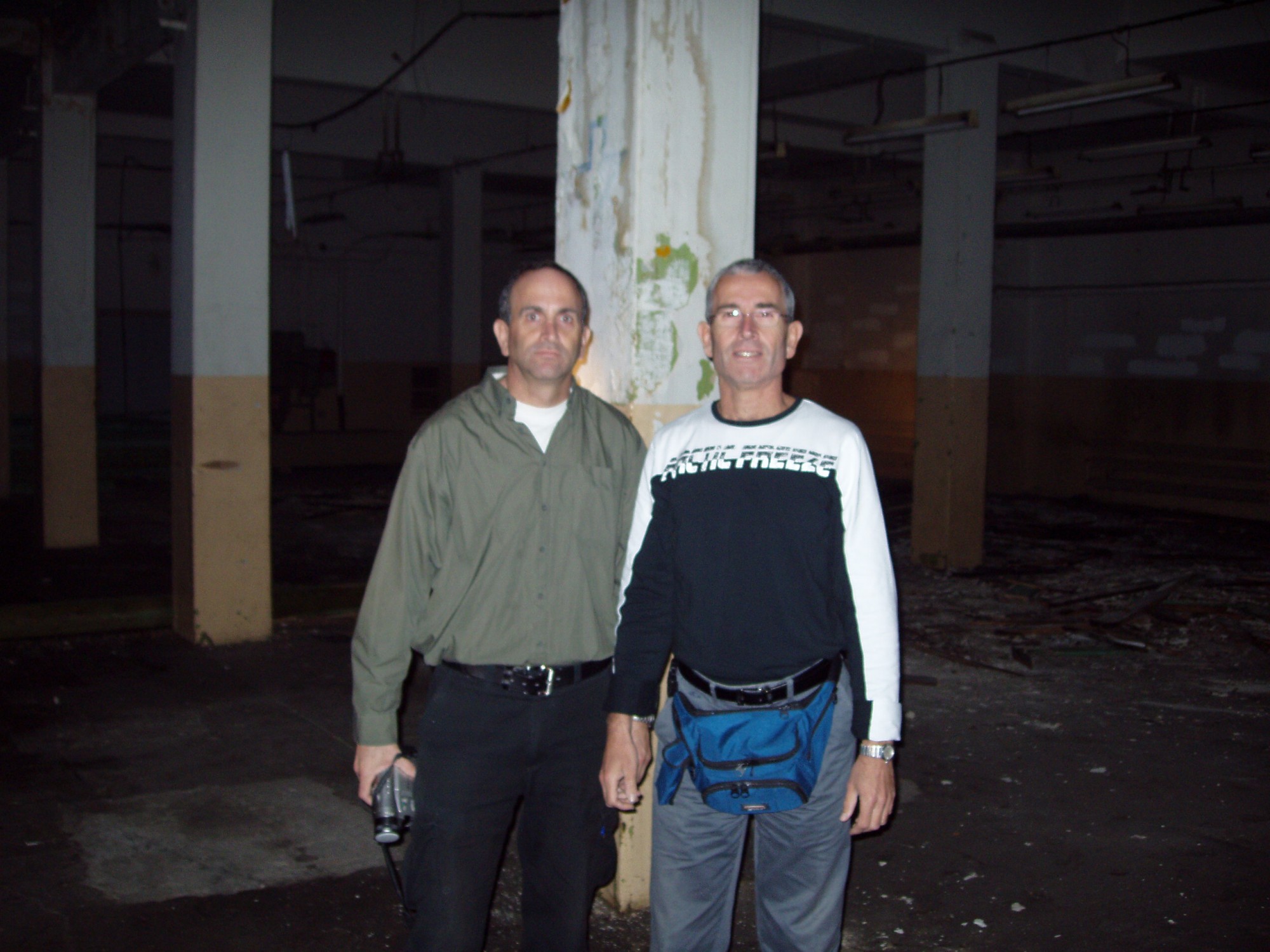The Journey back
Day 6
6th day: 22 October 2005
We woke up to a new morning. Breakfast at this hotel was good; we checked out and hit the road. In the original plan of this journey we didn't plan to visit Auschwitz II-Birkenau. Mom really did not want to visit that camp; her memories from that period were too hard for her to bear. Regardless, we decided we couldn't miss the opportunity. After discovering all the information and interesting leads from Stutthof, and as we had Tomash with us translating from Polish to Hebrew, we decided to visit the archive of Auschwitz II-Birkenau and attempted to find information regarding Sarah, or her family. As it was too hard for Sarah, I suggested we only enter the archive in Auschwitz, and not the one in Birkenau, even though that's where mom was stationed. I also recommended a visit to the Hungarian pavilion, and so we did.
On the way to Auschwitz, Tomash took us for a stroll in the Polish town Oświęcim (pronounced Oshpizin in Yiddish). This is a town in southern Poland, approximately 50 kilometers west of Kraków, near the confluence of the rivers Visla and Soła. The town was close to the worst camp of them all: Auschwitz.
Auschwitz was a network of concentration and extermination camps built and operated in Polish areas annexed by Nazi Germany during WWII. It was the largest of the German concentration camps, consisting of Auschwitz I (the base camp); Auschwitz II-Birkenau (the extermination camp); Auschwitz III-Monowitz, also known as Buna-Monowitz (a labor camp); and 45 smaller, satellite camps.
While Tomash was giving us a tour in the Polish town Oświęcim, he explained that literally the word Auschwitz in both Polish and German means 'maypole', or Maibaum. It actually refers to the Livna tree which had a white shell. This was a tradition going back to the 16th century. It is a decorated tree, or tree trunk, that is usually erected on 1 May. Just before the Maibaum gets erected, depending on the region, there is typically a procession through the village.
Auschwitz is the German name for Oświęcim, the town in and around which the camps were located; it was renamed by the Germans after they invaded Poland in September 1939. The Germans evacuated the Polish residents of Oświęcim and forced them to relocate. This also meant that the local residents of Oświęcim did not witness first-hand the destruction of the Jews from the area. It was an entire industry that carried an impact on more than just the Jews.
We entered a small Jewish museum located in the center of the town, named the Auschwitz Jewish Center, it dealt with the former Jewish life in Oświęcim. Jews were the majority demographic of this town for 150 years. Unfortunately, there are no Jews left there nowadays.
 |  |
In the excavations that were recently initiated, they found a synagogue which has now been partially reconstructed in one of the museum rooms.
 |  |
We continued to Auschwitz and entered the camp. It was a Saturday so there were no Israeli delegations visiting, but the camp was busy with visitors from all around the world, we recognized delegations from Germany, Russia, Hungary, Slovakia, and a few others.
We walked through the wide gate hanging the notorious signage: 'Arbeit macht frei' (translated: "work will set you free"/ "work liberates"). The slogan is well-known for being placed at the entrances to a number of Nazi concentration camps, including, most famously, Auschwitz I, where it was made by prisoners with metalwork skills and erected by order of the Nazis in June 1940. The phrase was adopted in 1928 by the Weimar Republic as a slogan extolling the effects of their desired policy of large-scale public works programs to end unemployment. It was continued in this usage by the NSDAP (Nazi Party) upon coming to power in 1933.
 |  |
When we arrived in Auschwitz we first went to the archive. Unfortunately, there was no option to enter and search for information. Our only option was to fill out a form at the entrance with questions and personal info, and then wait for their reply by regular post. At the end of our tour we decided to fill out the form asking for more information and records regarding Sarah Zauber hoping for any sort of lead or indication of records on her stay at Auschwitz. Thanks to the help of Tomash, and in hopes of getting an earlier reply, we wrote the questions in Polish.
While on our tour there, we encountered an older man who spoke German. He explained to a group of visitors about the time he was in Auschwitz. Tomash found his story interesting and we stood there to listen. Tomash explained from his story that many of the Jews were concentrated in the Birkenau camp and not in Auschwitz. We stopped to speak with this German survivor and his escorts.
 |  |
It turned out he was Jewish, and was 81 years old. After WWII, he returned to Germany. We didn't understand how he could choose to return to the country when the regime there tried to wipe out the Jewish race. His wife (who was a lot younger than him) did not understand what the issue was, and replied: "Germany of today is different." Avi told her we will never forget or forgive what had happened. As far as we saw it, there was no going back.
We continued our tour in Auschwitz and visited the Hungarian pavilion. Other countries also had their own pavilion, but the Hungarian one interested us the most. At the entrance to the building there was a big group of high school students who were about to enter. Some older people there spoke Hungarian and stood near us. Mom was glad to speak with them in her mother tongue, and they were kind enough to reply to all of her questions.

Sarah said that they were the teachers of the high school kids and they had come to visit as part of their school program in Hungary. Their city is located 60 kilometers from Budapest. They weren't Jewish, but their school has a program that included visiting Auschwitz. That was important for them.
We said our goodbyes and entered the building after the group had finished. I was there three years ago as an instructor of a high school delegation from Israel, as the acting tour guide for my high school group. I remembered that I came in for a short tour and visited the Hungarian pavilion along with the guide who was also a direct descendent of a Holocaust survivor.
To my surprise, the Hungarian pavilion seemed completely different this time. All the display was in multimedia now, slideshows and advanced technology, pictures displayed on the walls. The floor was made of glass and below it there were more things displayed. All of a sudden a young girl stepped closer to us, she was one of the Hungarian high-school delegation's students, and began speaking to Sarah in Hungarian. She said her father lived in Nyírbátor, the town near Budapest where Sarah lived before the war, her hometown. We were told only afterwards that one of the Hungarian teachers who Sarah spoke to had heard that she was from Nyírbátor; she searched for the girl and told her to speak with Sarah. It was a kind gesture.
 |  |
Mom was excited to speak with the nice young lady. It turned out that she no longer lived in Nyírbátor; only her dad still lived there. Sarah asked her for her dad's address since we would be visiting Nyírbátor and could send him her warm regards. She couldn't remember his address.
As we are about to leave the Auschwitz concentration camp, I went to the souvenir shop to buy some books and movies regarding the site. We sat for refreshments in the cafeteria and filled out the forms for Sarah, asking for information regarding her and her family. We handed them in wit the hope of receiving a fast reply. We also wanted to fill out forms for Sarah's two brothers, Bentzi and Yehuda. Bentzi passed away but Yehuda is still alive and also has a family in Israel. We didn't manage to get the forms properly filled out, however, since mom couldn't remember their foreign names, only their Hebrew ones.
Afterwards we would discover that Bentzi's foreign name was Bernard and Yehuda was Lipot.
We left Auschwitz, and Tomash took us to tour the surrounding area and then continue on to Birkenau.
Mom asked us not to go inside the camp; the memories were too difficult for her. Near Auschwitz, there were ruins of buildings that were part of the Nazi camp, but were not part of the site being toured and were therefore about to fall. We stopped near a small monument outside of Auschwitz on our way to Birkenau. There were two train cars.
 |  |
At that location, the trains which transported the Jews to the concentration camp would stop and disembark the passengers, and it was from there that they were led to the Birkenau camp. Only a while afterwards was the railway extended so the trains could enter through the front gate for the selection to be made there, near the railway, as you stepped down from the train.
When we arrived at Birkenau, we stopped to linger near the front gate, under the infamous sign, "work liberates." Mom stayed in the car. At that site, in 1944, her parents were killed, her brother Bentzi, other family members, and many people from her hometown. They were all selected for extermination.

We drove around the camp in order to grasp its vast size. It was a huge camp. We showed mom from a distance the pavilions where the woman's quarters had been located. We tried to show her the place which we knew, more or less, the Hungarian woman's pavilion had been located.
 |  |
We returned to Kraków in the early afternoon hours; we toured the city and then headed south to the Slovakian border. Since we hadn't eaten lunch, we stopped at a vegetarian restaurant, the same one we visited the night before. Their food was good and we preferred not eating meat since the three of us kept Kosher.
After lunch we continued to the city square, this time during the day time. The center was busy with many people, visitors and locals dining in restaurants, shopping and touring the city.
 |  |
During our stroll, we passed a nice doll store and I wanted to buy one for Lior. After we heard the high prices for tourist we decided to find something else to bring home. (These dolls were imported from Sweden). Avi and I did take a picture near the store, however.
We continued our tour and head off towards the Jewish quarters of Kraków, Kazimierz district.
This district was known for being home to a Jewish community from the 14th century until WWII. We passed the synagogues there; some of them were still active.

We passed the Remuh Synagogue (named after Rabbi Moses Isserles, known as ReMA). This is the smallest of all historic synagogues of the Kazimierz district of Kraków. We wanted to go inside but it closed at 5:00 p.m. and we didn't make it on time. There were other synagogues, though:
- Old Synagogue, now housing a Jewish History museum
- High Synagogue
- Izaak Synagogue
- Kupah Synagogue
- Tempel Synagogue, which is still active
- Old Jewish Cemetery in Kraków
From there we continued to the Kraków Ghetto, passing near a part of what used to be the ghetto wall. We saw the sign there. As it was getting dark, we decided to set our pace a little faster.
The Kraków Ghetto was one of the five main ghettos created by Nazi Germany while they occupied Poland.
We walked to the promenade, on the Visla River. We went to see the statue of the dragon which symbolizes Kraków. It was named the Wawel Dragon. The dragon is a famous part of Polish folklore. He made as his lair a cave under Wawel Hill on the banks of the Visla River. Wawel Hill is in Kraków, which was the capital at the time. In some stories, the dragon lived before the founding of the city, when the area was inhabited by farmers.
The metal sculpture of Wawel Dragon was built in 1970. It was placed in front of the dragon's den. It is stylized, with six legs, and, to the amusement of children, it noisily breathes fire every few minutes, thanks to a natural gas nozzle installed in the sculpture's mouth. Currently the dragon breathes fire every five minutes.
 |  |
Night was falling and we went for one last spin in the center of Kraków before we head back to the hotel. We visited the factory of Oskar Schindler. He was an ethnic German industrialist born in Moravia. He saved almost 1,200 Jews during the Holocaust by employing them in his enamelware and ammunitions factories, which were located in what are now Poland and the Czech Republic, respectively. The famous movie that was directed by Steven Spielberg, 'Schindler's List,' was based on his story. Schindler received the noble honor to be declared as Righteous Among the Nations.

Schindler's factory is abandoned nowadays, although there was an attempt to turn it into a museum, and it was also being renovated. There was a guard standing at the entrance and we entered to see a short video in English telling Schindler's story. On the second floor, we entered Schindler's room. There was a guest book which Avi and Tomash decided to look through.
Tomash told us that for 10 zloti the guard was willing to take us inside the factory. We happily accept and approached the guard, who seemed young and bored, probably could use our company to make it through his quiet night shift. We all went together, crossing the mud-filled yard until we reached the factory building. Unfortunately the light wasn't working since the building wasn't in use. The guard was resilient, however, and went to get a flashlight. Once we turned it on we could see that the building was completely empty, only bare walls. I truly hope they will restore what was there, or at least build a museum that would document Schindler's factory and what occurred there.
Afterwards, we said goodbye to Kraków and headed south to Zakopane where we would spend the night before finishing our trip in Poland.
After driving for an hour, we arrived at the hotel 'Vailla Tania' located in a small town. The hotel was actually a lovely villa with a wide garden. The owners were an Israeli couple that lived in Poland; we didn't get the chance to meet them as they were abroad at the time. The hotel was empty when we arrived, Tomash knew the owners, who had permitted us to enter. Their assistant greeted us and showed us the way inside. She told us where to set the luggage and mentioned that she would be preparing breakfast for us in the morning. She didn't sleep in the villa, and left for her own home after we had settled in. Sarah and Avi stayed in one room while I stayed in another. There were over ten rooms in the villa, and they were all empty at the time of our visit.

It was very cold; the nights during the fall and winter in Poland are very cold. This was the coldest night we had during our trip. It wasn't surprising since we were in a mountainous area. The Tatra Mountains constitute a mountain range forming a natural border between Slovakia and Poland, and is the tallest mountain range of the Carpathians. They occupy an area of 750 square kilometers. Most of Poland's topography is plain; this was one of the only mountainous areas.
Tomash, Avi and I drank coffee and tea on the second floor of the villa, and then decided to leave for a tour, despite the cold outside and our fatigue. Mom was tired and left for her room for a night sleep. On the local TV channels they showed a 50-year celebration of Euro-Vision, and we are glad to see the Israeli national singer who won, Dana International, singing 'Diva' in 1998. It was nice to see something Israeli on Polish TV.
We took a short drive to the center of the town and walked along the main streets. Most of the places were already closed and there weren't many people outside. It was freezing, not very pleasant outside for those of us who were Mediterranean-inclined. We found a nice local restaurant and stepped inside to warm up. They had a nice variety of dishes, fruit shakes, pizzas, toasts, and so on. We ordered hot cocoa, toast, and a pizza.

